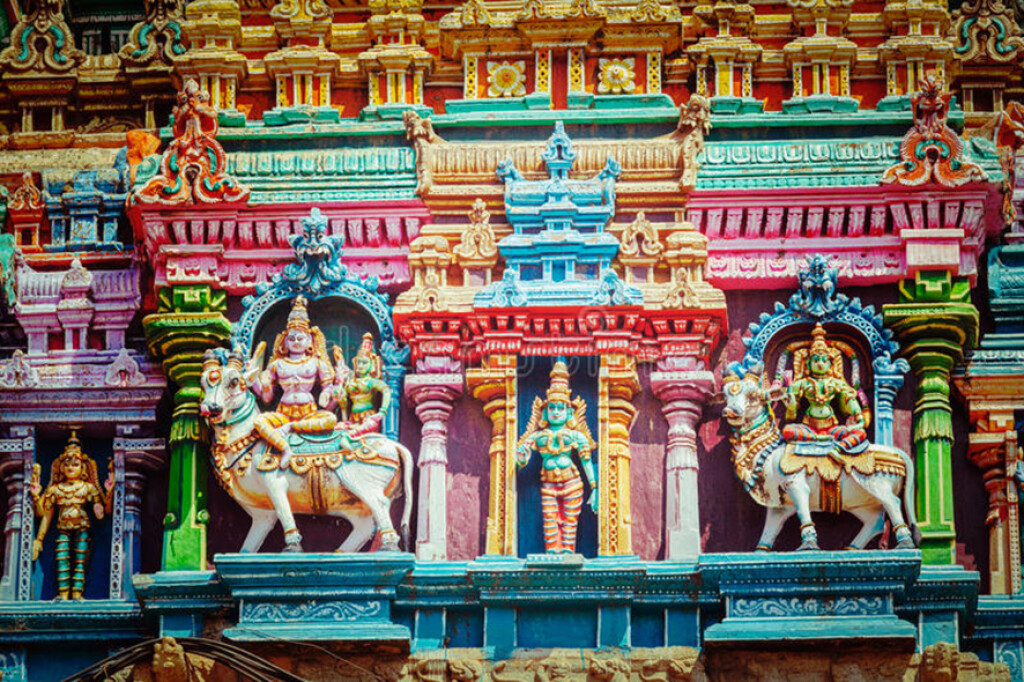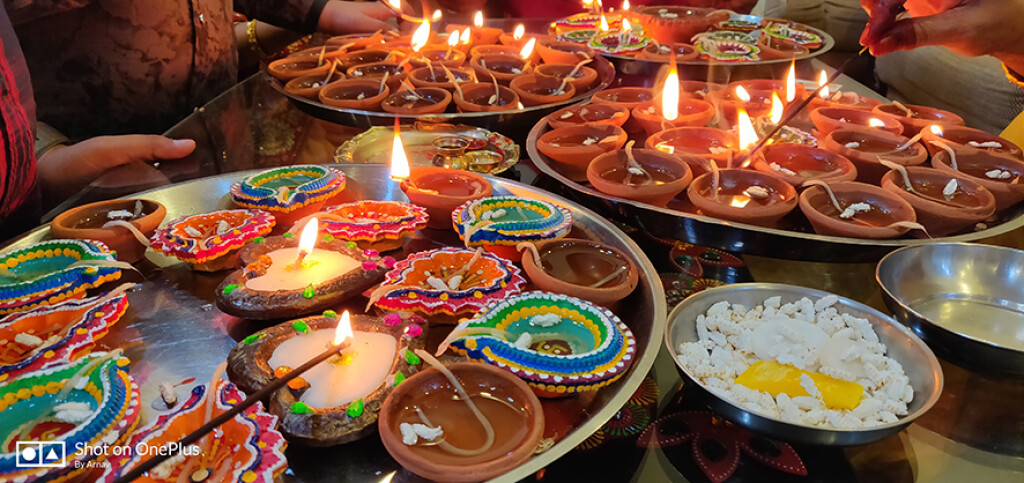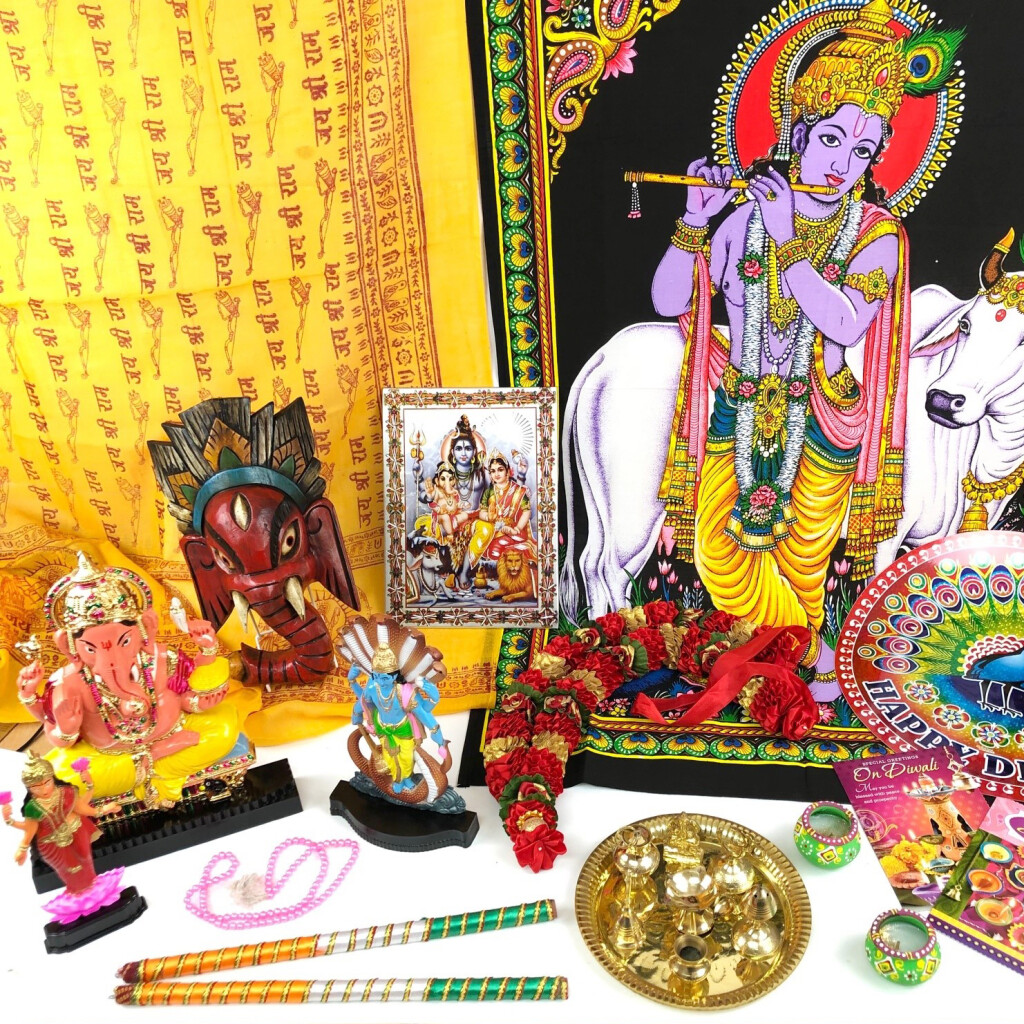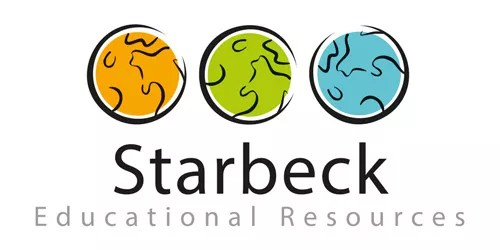Teaching Plan for Primary School Teachers to Teach about Hinduism.
Teaching Plan for Primary School.
Teaching children about different religions is an essential part of their education. It helps them understand and appreciate different cultures, beliefs, and traditions. In this article, we will provide a comprehensive teaching plan for primary school teachers to teach about Hinduism. We will also cover the items such as temple cloth, dancing sticks, sari, prayer beads, ganesh figure, rangoli pattern, hanuman figure, laxsmi, vishnu, and pooja set. We will explain how teachers can use these products to help children learn visually.

Understanding Hinduism
Before teaching about Hinduism, it is essential to have a basic understanding of this religion. Hinduism is one of the oldest religions in the world, with roots dating back to ancient India. Hinduism is a diverse religion with many different beliefs and practices, but some common beliefs include the following:
-
Belief in multiple gods and goddesses
-
Reincarnation and karma
-
Dharma or duty
-
Sacred texts such as the Vedas and Upanishads
-
The importance of meditation and yoga
Origins of Hinduism
The exact origins of Hinduism are unknown, but it is believed to have evolved from the ancient Indus Valley civilization. The religion has evolved over thousands of years and has been influenced by various other religions and cultures, including Buddhism and Jainism.
Basic Beliefs and Practices
Hinduism is a complex religion with many beliefs and practices, but some essential ones include:
-
Worship of multiple gods and goddesses
-
The belief in karma, reincarnation, and the cycle of birth and death
-
The importance of dharma or duty
-
The significance of meditation, yoga, and self-realization
Hindu Festivals
Hinduism has many festivals throughout the year, and these festivals are an essential part of Hindu culture. Some of the significant festivals include:
Diwali, also known as the Festival of Lights, is a major Hindu festival celebrated in India and other parts of the world. It usually falls in October or November and is celebrated for five days. The festival celebrates the victory of light over darkness, good over evil, and knowledge over ignorance.
During Diwali, people decorate their homes with lights and candles, create rangoli patterns on the ground, and light fireworks. They also exchange gifts and sweets with friends and family. Diwali is also a time for prayers and offerings to Hindu deities, particularly Goddess Lakshmi, who is associated with wealth and prosperity.
The festival has different meanings and traditions across different regions of India, but it is generally a time of joy, positivity, and renewal. In recent years, Diwali has also become a more global celebration, with many non-Hindu communities participating in the festivities.

Holi is a spring festival celebrated by Hindus in India and other parts of the world. It usually falls in March and is known as the Festival of Colors or the Festival of Love. The festival is a celebration of the victory of good over evil, the arrival of spring, and the end of winter.
During Holi, people gather in public spaces and drench each other with colored powder and water. This symbolizes the breaking down of social barriers and the coming together of people of all castes and backgrounds. The festival is also marked by singing, dancing, and feasting on traditional foods like gujiya and thandai.
Holi has its roots in Hindu mythology, particularly the story of Prahlad and Holika, which tells of the triumph of devotion and love over hatred and ego. The festival has also been associated with Krishna and Radha, who are said to have played Holi with their friends and lovers.
Holi is a time for forgiveness, reconciliation, and renewal. It is celebrated with great enthusiasm and joy across India and beyond, and has become a popular cultural event in many parts of the world.

Navratri is a nine-day Hindu festival celebrated in India and other parts of the world. It is dedicated to the worship of the Hindu goddess Durga and her nine manifestations, each of whom represents a different aspect of feminine power and divinity.
The festival usually falls in September or October and is celebrated with great devotion and enthusiasm by Hindus of all ages. During Navratri, people observe fasts, perform special prayers and pujas, and engage in cultural activities like singing, dancing, and storytelling.
Each day of Navratri is associated with a specific form of Durga and has its own significance and rituals. The first three days are dedicated to Durga's fierce form as Kali, while the next three days are dedicated to her nurturing form as Lakshmi. The final three days are dedicated to her wisdom form as Saraswati.
Navratri culminates in the festival of Dussehra, which marks the victory of good over evil and the triumph of Rama over the demon king Ravana. It is celebrated with the burning of effigies of Ravana, as well as fireworks, feasting, and exchanging of sweets and gifts.
Navratri is a time for introspection, purification, and renewal. It is celebrated with great fervor and devotion by Hindus around the world, and has become an important cultural event in many parts of India and beyond.
Using Visual Aids to Teach about Hinduism
Visual aids can be an effective way to teach children about Hinduism. Using different products such as temple cloth, dancing sticks, sari, prayer beads, ganesh figure, rangoli pattern, hanuman figure, laxsmi, vishnu, and pooja set can help children understand the religion better.

Temple Cloth
Temple cloth is a colorful and vibrant cloth used to decorate Hindu temples. It often features images of Hindu gods and goddesses and is used to create a sacred atmosphere. Teachers can use temple cloth to create a similar atmosphere in their classrooms when teaching about Hinduism.
Dancing Sticks
Dancing sticks are colorful wooden sticks used in Hindu dance forms such as Bharatanatyam and Kathak. Teachers can use dancing sticks to teach children about Hindu dance forms and their significance in Hindu culture.
Sari
The sari is a traditional Indian garment worn by women. It is a long piece of cloth draped around the body in various styles. Teachers can use the sari to teach children about traditional Indian clothing and its significance in Hindu culture. Children can also dress up to see what the clothes look like and feel like on the body.
Prayer Beads
Prayer beads, also known as mala, are used in Hinduism for chanting mantras and prayers. They are made of different materials such as sandalwood, tulsi wood, and rudraksha seeds. Teachers can use prayer beads to teach children about the importance of chanting mantras and prayers in Hinduism. Ask the children to create a mantra or a prayer and use the beads whilst chanting the mantra or prayer.
Ganesh Figure
Ganesha, also known as Ganapati or Vinayaka, is a revered deity in the Hindu religion. He is worshipped as the god of wisdom, knowledge, and new beginnings, and is considered to be the remover of obstacles and the patron of arts and sciences.
According to Hindu mythology, Ganesha is the son of Lord Shiva and his consort Parvati. He is known for his elephant head, which symbolizes wisdom, and his pot-bellied body, which represents the cosmic universe. Ganesha is also depicted with four arms, each of which holds a different object or symbol.
Ganesha is worshipped by Hindus of all castes and backgrounds, and his images and statues can be found in homes, temples, and public spaces throughout India and other parts of the world. He is particularly popular among students and artists, who seek his blessings and guidance in their pursuits.
The festival of Ganesh Chaturthi is dedicated to the worship of Ganesha and is celebrated with great devotion and enthusiasm by Hindus around the world. During the festival, people create clay idols of Ganesha and perform special prayers and rituals in his honor. The festival culminates with the immersion of the idols in water, symbolizing the return of Ganesha to his abode in the celestial realm.
Ganesha is a beloved and revered deity in the Hindu religion, and his worship is considered to be an important part of Hindu tradition and culture.
Rangoli Pattern
Rangoli is a traditional Indian art form that involves creating patterns on the floor using colored powder or sand. It is often created during Hindu festivals and is believed to bring good luck. Teachers can use the rangoli pattern to teach children about traditional Indian art forms and their significance in Hindu culture.
Hanuman Figure
Hanuman is a revered deity in the Hindu religion and is worshipped as the god of strength, devotion, and service. He is depicted as a humanoid with the face of a monkey and is considered to be one of the most powerful and loyal devotees of Lord Rama.
According to Hindu mythology, Hanuman was born to the monkey king Kesari and his consort Anjana. He is known for his great strength, courage, and devotion to Lord Rama, whom he helped rescue Sita from the demon king Ravana. Hanuman is also revered for his intelligence, humility, and selflessness.
Hanuman is a popular deity among Hindus of all castes and backgrounds, and his images and statues can be found in homes, temples, and public spaces throughout India and other parts of the world. He is particularly popular among those seeking strength, courage, and devotion in their lives.
The festival of Hanuman Jayanti is dedicated to the worship of Hanuman and is celebrated with great devotion and enthusiasm by Hindus around the world. During the festival, people perform special prayers and rituals in his honor and seek his blessings for strength, courage, and protection.
Hanuman is a beloved and revered deity in the Hindu religion, and his worship is considered to be an important part of Hindu tradition and culture.
Laxsmi and Vishnu Figures
Lakshmi and Vishnu are two of the most important deities in the Hindu religion. They are worshipped as the goddess of wealth and prosperity and the god of preservation, respectively.
According to Hindu mythology, Lakshmi is the consort of Vishnu and is known for her beauty, grace, and benevolence. She is often depicted with four arms, each of which holds a different symbol or object representing wealth, prosperity, and good fortune. Lakshmi is also associated with the lotus flower, which symbolizes purity and spiritual enlightenment.
Vishnu, on the other hand, is one of the three main deities in the Hindu religion, alongside Brahma and Shiva. He is known for his role as the preserver of the universe and is often depicted with four arms, each of which holds a different object or symbol representing his powers and attributes. Vishnu is also associated with the lotus flower, which symbolizes purity and spiritual enlightenment.
Lakshmi and Vishnu are worshipped by Hindus of all castes and backgrounds, and their images and statues can be found in homes, temples, and public spaces throughout India and other parts of the world. They are particularly popular among those seeking wealth, prosperity, and spiritual enlightenment in their lives.
The festival of Diwali, also known as the Festival of Lights, is dedicated to the worship of Lakshmi and is celebrated with great devotion and enthusiasm by Hindus around the world. During the festival, people create intricate rangoli patterns and light lamps and candles to welcome Lakshmi into their homes and seek her blessings. The festival also marks the return of Lord Rama to his kingdom after defeating the demon king Ravana and is celebrated with great joy and enthusiasm.
Lakshmi and Vishnu are beloved and revered deities in the Hindu religion, and their worship is considered to be an important part of Hindu tradition and culture.
Pooja Set
A pooja set is a collection of items used in the worship of Hindu deities. It typically includes various objects and symbols representing different aspects of the divine, as well as materials for making offerings and performing rituals.
Some of the items commonly found in a pooja set include a diya (a small oil lamp), incense sticks, camphor, flowers, sandalwood paste, and holy water. These items are used to create an atmosphere of purity and devotion during the worship of Hindu deities, and are believed to help the worshipper connect with the divine on a deeper level.
The use of a pooja set is an important part of Hindu worship and is considered to be a way of expressing gratitude, seeking blessings, and offering devotion to the gods and goddesses. It is typically used in the home or in a temple setting, and is performed by individuals or groups of worshippers.
The rituals performed with a pooja set may vary depending on the deity being worshipped and the specific tradition or region of Hinduism being followed. However, they generally involve the offering of flowers, food, and other items to the deity, the recitation of prayers and mantras, and the lighting of the diya and incense sticks to create a sacred atmosphere.
Overall, the pooja set is an important part of Hindu culture and tradition, and is used to help worshippers connect with the divine and seek blessings and guidance from the gods and goddesses of Hinduism.
Conclusion
Teaching about different religions is an essential part of a child's education. When teaching about Hinduism, using visual aids such as temple cloth, dancing sticks, sari, prayer beads, ganesh figure, rangoli pattern, hanuman figure, laxsmi, vishnu, and pooja set can help children learn visually and understand the religion better. By incorporating these items into their lesson plans, teachers can create a fun and engaging learning experience for their students.
FAQs
-
What is Hinduism? Hinduism is one of the oldest religions in the world, with roots dating back to ancient India. It is a diverse religion with many different beliefs and practices.
-
What are some of the essential beliefs of Hinduism? Some of the essential beliefs of Hinduism include the worship of multiple gods and goddesses, the belief in karma, reincarnation, and the cycle of birth and death, the importance of dharma or duty, and the significance of meditation, yoga, and self-realization.
-
What are some of the significant Hindu festivals? Some of the significant Hindu festivals include Diwali, the festival of lights, Holi, the festival of colors, Navratri, a nine-day festival celebrating the goddess Durga, and Raksha Bandhan, a festival celebrating the bond between brothers and sisters.
-
How can visual aids help teach children about Hinduism? Visual aids such as temple cloth, dancing sticks, sari, prayer beads, ganesh figure, rangoli pattern, hanuman figure, laxsmi, vishnu, and pooja set can help children learn visually and understand the religion better.
-
Why is it essential to teach children about different religions? Teaching children about different religions helps them understand and appreciate different cultures, beliefs, and traditions, and fosters respect and empathy towards others. It also promotes religious tolerance and understanding, which is crucial in today's diverse society.
Possible lesson plan of how to teach about the Hinduism Religion.
-
Introduction: Start by introducing the concept of Hinduism and why it's important to learn about different religions and cultures. Discuss how it can help promote empathy and respect towards others.
-
Temple cloth: Show students a temple cloth and explain what it is used for in Hinduism. You can also discuss the significance of colors and patterns in Hindu culture. Ask students to create their own temple cloth using paper and markers.
-
Dancing sticks: Show students how to use the dancing sticks, also known as dandiya, and play some traditional Indian music. Teach them a simple dance routine using the sticks.
-
Sari: Show students a sari and explain how it's worn in Hindu culture. You can also discuss the significance of different colors and patterns in saris. Ask students to design their own sari using paper and markers.
-
Prayer beads: Explain what prayer beads are and how they are used in Hinduism. Teach students a simple mantra or chant that they can repeat while using the prayer beads.
-
Ganesh figure: Show students a Ganesh figure and explain its significance in Hinduism. Discuss the story behind Lord Ganesh and his role in Hindu mythology. Ask students to create their own Ganesh figure using clay or play-doh.
-
Rangoli pattern: Show students some traditional rangoli patterns and explain how they are created using colored powders or rice. Ask students to create their own rangoli patterns using colored chalk on the ground.
-
Hanuman figure: Show students a Hanuman figure and explain its significance in Hinduism. Discuss the story behind Lord Hanuman and his role in Hindu mythology. Ask students to create their own Hanuman figure using paper and markers.
-
Laxmi and Vishnu figures: Show students Laxmi and Vishnu figures and explain their significance in Hinduism. Discuss the stories behind these deities and their roles in Hindu mythology. Ask students to create their own Laxmi and Vishnu figures using clay or play-doh.
-
Pooja set: Explain what a pooja set is and how it's used in Hinduism. Discuss the different items in the set, such as the diya lamp and incense holder. Ask students to create their own pooja set using paper and markers.
-
Visual learning: Throughout the lesson, emphasize the importance of visual learning in understanding different cultures and religions. Encourage students to use their senses to explore the items and concepts presented.
-
Conclusion: Wrap up the lesson by reviewing what students learned about Hinduism and the different items used in the religion. Emphasize the importance of respecting and learning about different cultures and religions.
Overall, this teaching plan incorporates a variety of items and activities to engage students and promote visual learning. By using hands-on activities and discussing the significance of different items, students can gain a deeper understanding and appreciation of Hinduism and other religions.














